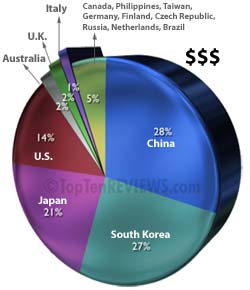Courses/Computer Science/CPSC 203/CPSC 203 2007Summer L60/CPSC 203 2007Summer L60 TermProjects/Stage 6: Who's watching Who?
Contents
Group
Group Name Trii Spii
Group Members Erika Lemon, Raman Kumar, Josh Laforet
Initial Project Statement
How does the accessibility of movies on the website stage6 violate predetermined standards for movie ratings and what are the consequences of providing movies to audiences who do not fulfill the minimum age requirements?
Background Information and Argument
The website Stage 6[[1]] has no parental controls that prevent minors from viewing streaming video that is inappropriate for their consumption. This is a problem because these movies can be viewed regardless of what their rating is which can cause different social issues to arise. This wiki will focus on 4 parts.
An introduction to the website Stage6:
- How movies are uploaded,
- How movies are downloaded,
- General overview of the operations of the website and the designers.
A introduction of the Movie ratings system:
- History of,
- Regulation of,
- Administering of the classification of movies.
A discussion of Stage6 and the ability of viewers to watch movies without a standard rating system in place
- Why there is no standard rating system.
- How do they regulate their movies, particularly over 18 movies.
Social issues that arise from the absence of this rating system:
- How are younger children and youth directly affected by early exposure to themes like violence and sexual content, and
- What implications does this exposure have.
Introduction to Stage6
Stage6 is an online file sharing community. GigaOm decided to launch their version of YouTube, using DivX. A well known software company known for it's coding and compression technology. It is essentially a high Quality YouTube.
The stage6.com site highlights the most popular videos viewed. Users can also rate each other's videos on developing "karma". "Karma" is based on how much a person participates in the community(rate videos, video comments, forums Blog, uploading etc. are a few ways of increasing karma). Stage6.com Plays all their video on DivX Codec which has become popular due to its ability to compress lengthy video segments into small sizes while maintaining relatively high visual quality. The DivX codec uses glossy MPEG-4 Part 2 compression, also known as MPEG-4 ASP, where quality is balanced against file size for utility. It is one of several codecs commonly associated with ripping, where audio and video multimedia are transferred to a hard disk and transcoded.
Movie Rating System
The Movie Ratings system [[2]] is in place as a structured guideline that helps audiences determine movie content before viewing movies.
The rating system was originally enacted November 1, 1968 and is comprised of 4 classes.
1) G for General Audiences, all ages admitted
2) PG for mature audiences - parental guidance suggested, but all ages admitted
3) PG-13 for Restricted, children under 16 would not be admitted without an accompanying parent or adult guardian
4) NC-17 for no one under 17 admitted.
Movies are given a classification by a specially designed committee comprised of 8-13 men and women called the film rating board of the Classification and Rating Administration. As a group they view a movie and each member gives the movie a rating that they feel is appropriate. Next, the Board votes on the rating and each rating is based on majority vote.
There are many factors which determine how a movie should be rated. Theme, violence, language, nudity, sensuality, drug abuse, and other factors are all judged by a Rating Board which results in the appropriate rating.
The enforcement of ratings are voluntary by theater owners yet the National Association of Theatre Owners estimates that the majority of theatre owners abide by the ratings.
Stage6 and Movie Regulations
"The Internet, a global "network of networks" is not governed by a government or private entity. This vacuum leaves no checks or limits on the information maintained or made accessible to users. No person or entity owns the Internet, leaving no one accountable for the accidents which occur on its highways." (Federal Bureau of Investigation, Washington, D.C., 1996.)
This very quote is quite possibly the reason that Stage6.com has no ratings system in place. From personal experience we, the Trii Spii group were all able to set up a free account and within minutes we could each download sexually explicit images and videos with no prompts requesting our ages, verifying that we were indeed old enough to view this content. However you have to be 13 to set up an account.
There is nothing which would impact Stage6 legally because the internet is not a government or private entity. What is shown on the internet has no bearing for consequence and it is through such avenues that children are able to access sexually explicit material.
With the advance of technology such as the internet and streaming video, gone are the days of screening audiences to verify ages before viewing rated movies. As mentioned before the ratings system is not a legal entity but is more like a social standard. Years ago, children would not be allowed to purchase a ticket for entry into a R-rated movie, however now with the advances in technology a minor under 18 years old, can set up an account and within minutes view sexually explicit content.
Arising Social Issues
The introduction of the internet has allowed children and teenagers easy accessibility to themes like violence and sex, through media components like movies. These movies can be found within seconds and are usually free and unmonitored, as compared to attending a movie at a theater. With this accessibility and early exposure there are different implications and social issues that arise. Although these facts do not pertain to the entire population nor is this exposure a direct causation of these outcomes, what had been discovered is that there is a significant correlation between early exposure of violence and sexual content with negative responses expressed by children and youth.
When discussing the issues of the affects of early exposure to violence and sexual material, violence will be focused on first. Early exposure to violence has been known to create false conceptions about violence; hence younger children have a higher tendency to become desensitized to these images and because of this children may start to react the same to real life situations as they would to movie situations. It is also felt that by making violence a normal and acceptable way to resolve conflicts, like they do in movies; it will affect and promote this behavior in children. These violent images can also cause a child to develop violent tendencies, like; increased aggression and anti-social behavior, increased fear of being a victim and increased desire for violence in their life (fictional or real).
When talking about negative sexual content, this easily accessible early exposure through the internet counteracts the healthy and appropriate images and ideas that parents and/or teachers are trying to instill in young people. Children and teenagers have the tendency to imitate what they see and because of this, teenagers especially, can be highly impacted. This exposure also causes desensitizing behavior and can encourage teenagers to have increased involvement in deviant sexual behavior, as well as act out sexually against younger children. It also has the ability to instill the idea of actions without responsibility; hence it can directly affect a child’s health, in the form of contracting diseases or pregnancy.
Facts about Violence
"The Oklahoma bombing suspect obtained a copy of the "Turner Diaries," a book which advocates the violent overthrow of government, off the Internet. Whereas before, one would have had to know exactly where to look and be pre-disposed to search for the book, the Internet made it easily accessible to a global audience."
How Violence on T.V affects children (ideas are transferable to internet movies)
"44 percent of the violent interactions on television involve perpetrators who have some attractive qualities worthy of emulation."
"43 percent of violent scenes involve humor either directed at the violence or used by characters involved with violence."
"Nearly 75 percent of violent scenes on television feature no immediate punishment for or condemnation of violence."
"40 percent of programs feature "bad" characters who are never or rarely punished for their aggressive actions."
"In homes where no physical or emotional violence is present, children are still bathed in violent images; the average child spends more than three hours a day watching television. Television, videogames, music and film have become increasingly violent (Donnerstein et al., 1995). Huston and colleagues have estimated that the average 18 year old will have viewed 200,000 acts of violence on television (Huston, et al., 1992). Even with solid emotional, behavioral, cognitive and social anchors provided by a healthy home and community, this pervasive media violence increases aggression and antisocial behavior (Lewis et al., 1989; Myers et al., 1995; Mones, 1991; Hickey, 1991; Loeber et al., 1993; O'Keefe, 1995), contributes to a sense that the world is more dangerous than it is (Gerbner, 1992) and desensitizes children to future violence (Comstock and Paik, 1991). In children exposed to violence in the home, these media images of power and violence are major sources of ‘cultural’ values, reinforcing what they have seen modeled at home" -The Vortex of Violence-How Children Adapt and Survive in a Violent World, Interdisciplinary Education Series, Bruce D. Perry, M.D., Ph.D.
Facts about Pornography and the internet.
A Google [[3]] search of XXX movies returns 4,340,000 results in 0.07 seconds.
Every Second - $3,075.64 is being spent on pornography
Every second - 28,258 Internet users are viewing pornography
Every second - 372 Internet users are typing adult search terms into search engines
Every 39 minutes: a new pornographic video is being created in the United States.
The pornography industry has more annual revenue than the revenues of the top technology companies combined: Microsoft, Google, Amazon, eBay, Yahoo!, Apple, Netflix and EarthLink.
Children Internet Pornography Statistics
Average age of first Internet exposure to pornography-11 years old
Largest consumer of Internet pornography-35 - 49 age group
15-17 year olds having multiple hardcore exposures-80%
8-16 year olds having viewed porn online-90% (most while doing homework)
7-17 year olds who would freely give out home address-29%
7-17 year olds who would freely give out email address-14%
Children's character names linked to thousands of porn links-26 (Including Pokemon and Action Man)
Internet Pornography Statistics
Pornographic websites 4.2 million (12% of total websites)
Pornographic pages 420 million
Daily pornographic search engine requests 68 million (25% of total search engine requests)
Daily pornographic emails 2.5 billion (8% of total emails)
Internet users who view porn 42.7%
Received unwanted exposure to sexual material 34%
Average daily pornographic emails/user 4.5 per Internet user
Monthly Pornographic downloads (Peer-to-peer) 1.5 billion (35% of all downloads)
Daily Gnutella "child pornography" requests 116,000
Websites offering illegal child pornography 100,000
Sexual solicitations of youth made in chat rooms 89%
Youths who received sexual solicitation 1 in 7 (down from 2003 stat of 1 in 3)
Worldwide visitors to pornographic web sites 72 million visitors to pornography: Monthly
Internet Pornography Sales $4.9 billion
Adult Internet Pornography Statistics
Men admitting to accessing pornography at work 20%
US adults who regularly visit Internet pornography websites 40 million
Promise Keeper men who viewed pornography in last week 53%
Christians who said pornography is a major problem in the home 47%
Adults admitting to Internet sexual addiction 10%
Breakdown of male/female visitors to pornography sites 72% male - 28% female
It is obvious that the internet and our society are plagued by the presence of pornography. Of importance is the statistics of pornography and children. The availability of explicit materials to children is readily available via websites such as Stage6. The following is a statement about the lax controls on adult content available to children under the guise of inclusiveness "Stage6 is inclusive. Everyone is welcome here. Stage6 is above all else an open forum, with low barriers to entry. We want to make it easy for everyone to participate" This 'inclusiveness' gives children the oppourtunity to download and view adult rated content with no control or discretion as to who is viewing the content.
Conclusion
Stage6 is not breaking any legal laws by allowing users to share divX files. They are however breaking social norms by providing a venue for minors to access sexually explicit material. Stage6 is not a adult only site. Many shared files are acceptable for viewing by all audiences, however there are some instances where the material being viewed should have some sort of administrative monitoring in place to prevent under age audiences from accessing explicit content. Such solutions may include a simple question where the user must enter the year they were born before being granted access into some parts of the website, or possibly entering a credit card number to verify that the user is at least 18. Although not perfect and easy to get around, these possible solutions would present a deterrent to some minors.
We feel that something is better than nothing, and feel that if Stage6 wants to continue to provide a forum for file sharing, they should be responsible for what content is shown, and to whom the content is being viewed by.
References
Introduction to Stage6
- http://stage6.divx.com/info/terms_of_use
- http://theutubeblog.com/2007/02/07/copyright-problems-intensify-for-youtube/
- http://digg.com/videos/educational/Why_Video_Submitters_Should_Upload_to_Stage6_and_NOT_Youtube_A_Comparison
Movie Rating System
- http://www.mpaa.org/Ratings_HowRated.asp
- http://www.filmratings.com/
- http://www.mpaa.org/FilmRatings.asp
Stage6 and Movie Regulations
Arising Social Issues
- http://www.suite101.com/article.cfm/media_literacy/42205
- http://www.cief.ca/research_reports/harm.htm#internet
- http://www.protectkids.com/effects/harms.htm
- http://internet-filter-review.toptenreviews.com/internet-pornography-statistics.html
- http://www.safeyouth.org/scripts/faq/mediaviolstats.asp
- http://www.yellodyno.com/html/violence_as_ent_stats.html
External Links
- http://www.mpaa.org/FilmRatings.asp
- http://www.filmratings.com/
- http://www.aap.org/family/ratingsgame.htm
- http://www.webtvwire.com/fcc-out-of-touch-with-internet-tv/
- http://sify.com/parent.php
- http://www.mpaa.org/Ratings_HowRated.asp
- http://www.webtvwire.com/interview-with-darrius-thompson-of-divx-about-the-new-stage6-beta-15-questions/
- http://gigaom.com/2006/08/23/stage6-divxs-quality-youtube/
- http://www.webtvhub.com/stage-6-beta-review/
- http://digg.com/videos/educational/Why_Video_Submitters_Should_Upload_to_Stage6_and_NOT_Youtube_A_Comparison
- http://www.givemeaning.com/blog/2006/08/stage6-so-much-better-than-youtube.html
- http://www.divxmovies.com/info/
- http://www.divxmovies.com/video/
- http://www.nap.edu/netsafekids/pp_li_il.html
- http://www.isoc.org/internet/law/
- http://searchvoip.techtarget.com/sDefinition/0,,sid66_gci213055,00.html
- http://www.cpsc.gov/streaming.html
- http://tprc.alberta.ca/albertafilmratings/movie_ratings_guide/pg.aspx
- http://www.jstor.org/view/00027162/ap030711/03a00050/0?currentResult=00027162%2bap030711%2b03a00050%2b0%2cFEFF&searchUrl=http%3A%2F%2Fwww.jstor.org%2Fsearch%2FBasicResults%3Fhp%3D25%26si%3D1%26gw%3Djtx%26jtxsi%3D1%26jcpsi%3D1%26artsi%3D1%26Query%3Dparental%2Bguidance%2Bin%2Bmovies%26wc%3Don
- http://www.jstor.org/view/00224499/ap060147/06a00020/0?currentResult=00224499%2bap060147%2b06a00020%2b0%2c07&searchUrl=http%3A%2F%2Fwww.jstor.org%2Fsearch%2FBasicResults%3Fhp%3D25%26si%3D1%26gw%3Djtx%26jtxsi%3D1%26jcpsi%3D1%26artsi%3D1%26Query%3Dinternet%2Bmovies%2Band%2Bsocial%2Bissues%26wc%3Don
- http://www.suite101.com/article.cfm/media_literacy/42205
- http://books.nap.edu/openbook.php?record_id=11706&page=4
- http://www.cief.ca/research_reports/harm.htm#internet
- http://www.protectkids.com/effects/harms.htm
- http://www.thecpac.com/
- http://www.nationalcoalition.org/resourcesservices/pornharm.html
- http://stage6.divx.com/info/terms_of_use
- http://www.letsgodigital.org/en/13688/online_video_channel/\
- http://www.veoh.com/
- http://mashable.com/2006/08/24/stage6-divxs/
- http://www.dailymotion.com/tag/stage6
- http://www.podtech.net/scobleshow/search/Stage6
- http://labs.divx.com/
- http://momb.socio-kybernetics.net/alpha/divx-stage6
- http://theutubeblog.com/2007/02/07/copyright-problems-intensify-for-youtube/
- http://www.usatoday.com/tech/news/2007-02-02-viacom-youtube_x.htm
- http://internet-filter-review.toptenreviews.com/internet-pornography-statistics.html


-01.gif)
-01.gif)
-01.gif)

